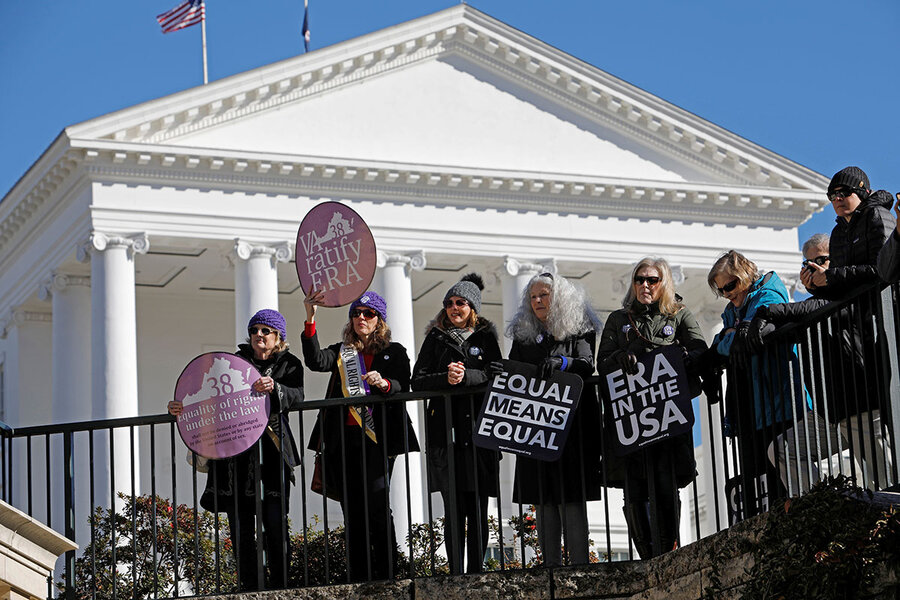Will the Equal Rights Amendment cross the finish line? Three questions.
When an effort to enshrine a new principle within the U.S. Constitution stretches on for generations, it offers up a past-meets-present twist on democratic deliberation.
Now the federal government is trying to determine what the next steps are, after the required three-quarters of the states have ratified the Equal Rights Amendment (ERA), which affirms, “Equality of Rights under the law shall not be denied or abridged by the United States or by any State on account of sex.”
Q: Why is the ERA – approved by Congress in 1972 – back in the news now?
In January, Virginia became the 38th state to ratify the ERA. But people disagree on whether it has now met the requirements to become the 28th Amendment. By 1977, 35 states had approved the amendment, but then momentum stalled. Not until 2017 did an additional state, Nevada, ratify the ERA; Illinois joined the list the following year.
ERA supporters declare victory, saying Virginia’s ratification means the ERA has fulfilled the conditions laid out in Article 5 of the Constitution. But the National Archives and Records Administration refuses to certify the ERA, citing an opinion from the U.S. Department of Justice that because the final ratifications happened after a deadline set by Congress, the amendment is invalid.
Congress extended a 1979 deadline to 1982, but there are lawsuits pending over the legitimacy of those deadlines. Meanwhile, the U.S. House of Representatives voted on Feb. 13 to remove the deadline. ERA supporters are now watching to see if a similar bipartisan resolution in the Senate will be allowed to move forward for a vote.
If the ERA does become the 28th Amendment, it wouldn’t be the first time the Constitution changed at a snail’s pace. It took nearly 203 years for enough states to ratify the 27th Amendment, proposed in 1789, to restrict when Congress can raise its pay.
Another debate: whether to count five states that voted to rescind or sunset their ratification of the ERA. Other amendments, including the 14th and 15th, have made it into the Constitution with states that were counted despite attempts to backtrack on ratifying, says Vivian Hamilton, a professor at William & Mary Law School in Williamsburg, Virginia.
These questions are expected to make their way to the U.S. Supreme Court.
Q: Hasn’t legal equality between men and women already been established?
Since the 1970s, many laws that discriminated against women have been struck down through the 14th Amendment’s equal protection clause.
Today’s ERA proponents applaud such progress, but say that without a constitutional guarantee, women have bumped up against limits as they’ve sought redress for gender-based violence and discrimination.
“The ERA in the Constitution would give Congress more scope of authority to pass legislation to protect women in various ways,” says Jessica Neuwirth, author of “Equal Means Equal: Why the Time for an Equal Rights Amendment Is Now” and co-founder and co-president of the ERA Coalition.
There’s also value in sending “a clear message to all Americans that at the highest level of the law, women are now equal citizens,” Ms. Neuwirth says.
But some advocates for women’s rights say the ERA could be interpreted by conservative-leaning courts in a way that would strike down important protections for women – and they’d rather start fresh with a new amendment. These scholars argue that it “would be more robust ... if it contained explicit language authorizing policies that would affirmatively promote women’s equality,” Professor Hamilton says, citing examples from such countries as France and Germany.
Q: What opposition does the ERA face?
Some Republican members of the House are among those who have raised concerns about how the ERA could prompt courts to overturn abortion limits.
Twenty-four states have their own ERAs or other constitutional guarantees of equality on the basis of sex, and the effect on abortion rules has been mixed. The New Mexico Supreme Court, for example, cited the state’s ERA when it struck down a regulation that restricted public funds for abortions within Medicaid. In Pennsylvania, on the other hand, which also has a state ERA, a variety of restrictions on abortion have been upheld.
Opponents also say the federal amendment could be used to offer constitutional protection to fluid notions of gender identity, and to prohibit discrimination based on sexual orientation. How the courts would interpret the word “sex” in the ERA is an “unsettled issue,” Professor Hamilton says.
In surveys since the 1970s, a majority of Americans have consistently supported an amendment for equal rights between men and women.
Editor’s Note: This story was updated on Feb. 13 to include the results of the House vote.







